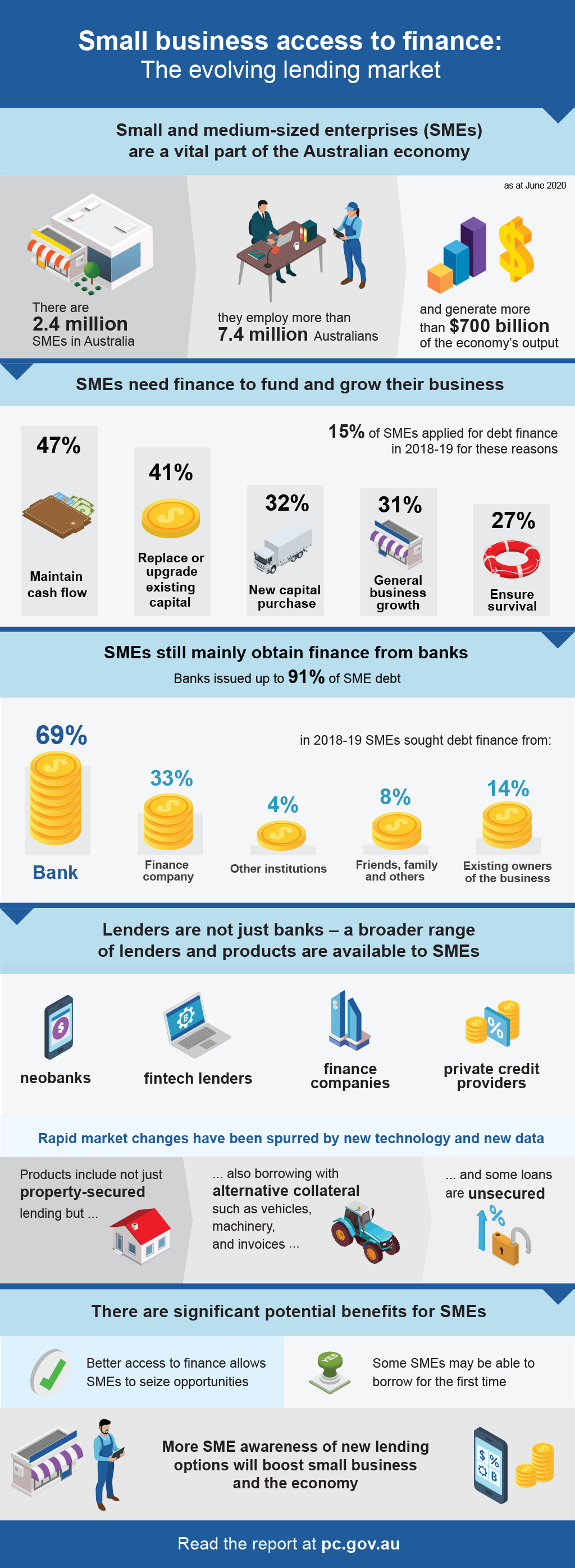Small business access to finance: The evolving lending market
Commission research paper
This research paper was released on 30 September 2021. It examines how small and medium enterprises (SMEs) access debt finance in Australia.
The paper finds that the recent emergence of new products and lenders, enabled by a supportive regulatory environment and innovative use of data and technology, has expanded the lending options available to SMEs.
Download the paper
- Small Business Access to Finance: The evolving lending market (PDF - 948 Kb)
- Small Business Access to Finance: The evolving lending market (Word - 2038 Kb)
- Infographic
- Media release
- Contents

Text version of the infographic
Small business access to finance: The evolving lending market
Small and medium-sized enterprises (SMEs) are a vital part of the Australian economy.
As at June 2020, there are 2.4 million SMEs in Australia, they employ more than 7.4 million Australians and generate more than $700 billion of the economy’s output.
SMEs need finance to fund and grow their business
15% of SMEs applied for debt finance in 2018-19 for these reasons:
- 47% Maintain cash flow
- 41% Replace or upgrade existing capital
- 32% New capital purchase
- 31% General business growth
- 27% Ensure survival.
SMEs still mainly obtain finance from banks
Banks issued up to 91% of SME debt. In 2018-19 SMEs sought debt finance from:
- 69% Bank
- 33% Finance company
- 4% Other institutions
- 8% Friends, family and others
- 14% Existing owners of the business.
Lenders are not just banks — a broader range of lenders and products are available to SMEs
- neobanks
- fintech lenders
- finance companies
- private credit providers.
Rapid market changes have been spurred by new technology and new data.
Products include not just property-secured lending but also borrowing with alternative collateral such as vehicles, machinery and invoices, and some loans are unsecured.
There are significant potential benefits for SMEs
- Better access to finance allows SMEs to seize opportunities
- Some SMEs may be able to borrow for the first time.
More SME awareness of new lending options will boost small business and the economy.
Read the report at pc.gov.au
New lending options boost small business and the economy
Changes to lending markets over the last decade means there are now a wide range of finance options available for small businesses that don’t require property as security, according to a new report by the Productivity Commission.
“Every year, one in six small and medium enterprises (SMEs) seeks finance to fund and grow their business. Traditional SME loans are usually secured by property. But spurred by new technology and new data, lenders now have more capacity and confidence to lend to SMEs using other forms of collateral or even lending unsecured,” Productivity Commissioner Catherine de Fontenay said.
There are 2.4 million SMEs in Australia employing more than 7.4 million Australians. “These businesses are the engine room of the Australian economy and a healthy small business sector is vital to the economy, especially as we recover from the COVID pandemic,” Commissioner de Fontenay said.
The report points to a significant evolution in the lending market for SMEs over the last decade, driven by technology and new business models.
While SMEs still mainly obtain their finance from the major banks, there is now a much broader range of products available from traditional and new lenders.
“A broader range of products can provide SMEs with finance more quickly and flexibly, allowing them to seize opportunities. Some SMEs may even be able to borrow for the first time,” Productivity Commissioner Malcolm Roberts said.
SMEs may not be aware of all their lending options and may not feel confident about new options. Brokers can help match them with appropriate lending options.
“Finding the right product may be challenging, but the benefits can be significant,” Commissioner Roberts said.
The report found the finance market is increasingly competitive, which will drive further improvements in access to finance for SMEs.
The full report on Small business access to finance: The evolving lending market can be found at: www.pc.gov.au.
Media requests
02 6240 3330 / media@pc.gov.au
- Preliminaries: Cover, Copyright and publication detail, Contents and Acknowledgments
- Executive summary
- 1. Why this study?
- 1.1 SMEs are a large part of the economy
- 1.2 SMEs prefer debt over equity, and have diverse needs
- 1.3 This study examines the evolving SME lending market
- 2. The traditional SME lending landscape
- 2.1 Secured lending by banks is a significant part of the market
- 2.2 There are mixed views on access to finance
- 3. The emergence of new lenders and products
- 3.1 Regulatory and technological changes have opened new opportunities
- 3.2 Few barriers exist, enabling lenders to enter and grow
- 3.3 SMEs have a diverse range of lending options available
- 3.4 New lending options have significant benefits for SMEs
- 4. Future market opportunities and implications
- 4.1 Improving data capabilities and funding will enable further growth
- 4.2 SMEs could be more aware of and confident in newer lending options
- 4.3 More visibility is required for future research
- A. Conduct of research
- B. Data used in the analysis
- B.1 BLADE data for Australian SMEs
- B.2 SAFE data for European SMEs
- Abbreviations
- References
Printed copies
Printed copies of this report can be purchased from Canprint Communications.
Publications feedback
We value your comments about this publication and encourage you to provide feedback.